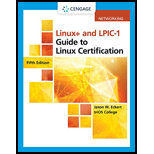1. Make a directory under your home directory called documents. Next, make a directory under the documents directory called spreadsheets. What is the absolute path for the spreadsheets directory? 2. Use the cat command to create a two-line file in your home directory called datainfo. On the first line, enter 144, and on the second line, enter 288. After the file is created, copy it from your home directory to the spreadsheets directory you created. 3. Set the permissions on the datainfo file so that the owner, group, and others can read and execute the file. (Otherwise, leave the default settings as is) 4. Append the current month's calendar to the datainfo file that is in your home directory. Next, copy your changed datainfo file over the older datainfo file in the spreadsheets directory, but use the copy option that prompts you before you overwrite the file in the spreadsheets directory. Check the contents of the datainfo file in the spreadsheets directory to make certain your copy was successful. 5. Make the spreadsheets directory in your working directory. Make copies of the datainfo file in the spreadsheets directory, so that one copy is named myinfo and one is named datadata. Next, use a wildcard character combination to list all files that have "ata" as the second, third, and fourth characters. 6. Make certain you are in your home directory. Change your command prompt so that it shows your current working directory with an exclamation point, such as mydirectory! 7. Change to your home directory. Use the rmdir command to delete the spreadsheets directory. What happens? 8. Delete the datainfo files in both your home directory and in the spreadsheets directory. Also, delete the myinfo and datadata files in the spreadsheets directory. 9. Change to your home directory. Delete the spreadsheets directory and then delete the documents directory. 10. Create a directory called secure under your home directory. Next, using the octal permission format, set security on the secure directory so that you have all permissions and no one else has any permissions.
1. Make a directory under your home directory called documents. Next, make a directory under the documents directory called spreadsheets. What is the absolute path for the spreadsheets directory?
2. Use the cat command to create a two-line file in your home directory called datainfo. On the first line, enter 144, and on the second line, enter 288. After the file is created, copy it from your home directory to the spreadsheets directory you created.
3. Set the permissions on the datainfo file so that the owner, group, and others can read and execute the file. (Otherwise, leave the default settings as is)
4. Append the current month's calendar to the datainfo file that is in your home directory. Next, copy your changed datainfo file over the older datainfo file in the spreadsheets directory, but use the copy option that prompts you before you overwrite the file in the spreadsheets directory. Check the contents of the datainfo file in the spreadsheets directory to make certain your copy was successful.
5. Make the spreadsheets directory in your working directory. Make copies of the datainfo file in the spreadsheets directory, so that one copy is named myinfo and one is named datadata. Next, use a wildcard character combination to list all files that have "ata" as the second, third, and fourth characters.
6. Make certain you are in your home directory. Change your command prompt so that it shows your current working directory with an exclamation point, such as mydirectory!
7. Change to your home directory. Use the rmdir command to delete the spreadsheets directory. What happens?
8. Delete the datainfo files in both your home directory and in the spreadsheets directory. Also, delete the myinfo and datadata files in the spreadsheets directory.
9. Change to your home directory. Delete the spreadsheets directory and then delete the documents directory.
10. Create a directory called secure under your home directory. Next, using the octal permission format, set security on the secure directory so that you have all permissions and no one else has any permissions.
Trending now
This is a popular solution!
Step by step
Solved in 2 steps


